This page contains affiliate links. Please read our disclosure for more info.
Travelling by train is one of the things we love most about Japan. There’s an extensive network, the trains are spacious and comfortable, and they always run on time (we even made a one-minute connection!).
The only downside is the price. Buying a Japan Rail Pass in advance used to save you a lot of money, but that has changed with a price increase in October 2023.
In this review, I’ll explore whether a Japan Rail Pass is worth it any longer and share useful tips for using the pass and travelling by train in Japan.
Contents
- Update: Japan Rail Pass Price Increase
- What is a Japan Rail Pass?
- Japan Rail Pass Price
- Which Trains are the Japan Rail Pass Valid On?
- Is a Japan Rail Pass Worth It?
- Our Savings with a Japan Rail Pass
- A Tokyo to Kyoto Sample Itinerary and Savings
- When Not to Use a Japan Rail Pass
- Where to Buy a Japan Rail Pass
- How to Exchange a Japan Rail Pass
- Can You Use a Japan Rail Pass for Local Transport in Tokyo and Kyoto?
- Finding Train Times
- Making Seat Reservations
- How to Use a Japan Rail Pass
- Japanese Train Etiquette
- Is a Japan Rail Pass Worth it?
- More Reading to Plan Your Japan Trip
Update: Japan Rail Pass Price Increase
The cost of the Japan Rail Pass increased significantly (around 70%) in October 2023.
Unfortunately, this means that for most visitors, the Japan Rail Pass no longer saves you money.
This is such a shame as I absolutely love the convenience of travelling with a pass. You should still consider a Japan Rail Pass if:
- You are travelling a lot – For example for a trip that includes Tokyo to Kyoto return with a day trip to Hiroshima (see the itinerary below), a pass now costs about the same as individual tickets.
- You prioritise convenience – It’s so nice being able to hop on trains without buying a ticket.
Another change with the new passes is that you can use it on the fastest shinkansen trains (Nozomi and Mizuho), but you have to pay a hefty supplementary fee (4960 yen/ US $33 from Tokyo to Kyoto). This isn’t worth it to reach Kyoto 20 minutes faster.
What is a Japan Rail Pass?
A Japan Rail Pass is a ticket that provides unlimited travel on all Japan Rail national trains for a certain period. Passes are available for 7, 14 or 21 consecutive days and you can choose between a standard and green (first class) pass.
Japan Rail Passes are only available to foreigners travelling on a tourist visa and (usually) must be bought outside Japan.
You can buy your pass online and get it delivered to your home address or even to your first Japan hotel if you’ve left it to the last minute.
Japan Rail Pass Price
This is the current cost of each of the standard Japan Rail Passes in Japanese yen with the current approximate exchange rate in US dollars and the cost per day in dollars.
| Japan Rail Pass | Cost in Yen | Cost in $ | Cost per Day in $ |
|---|---|---|---|
| 7 Day JR Rail Pass | ¥50,000 | $325 | $46 |
| 14 Day JR Rail Pass | ¥80,000 | $521 | $37 |
| 21 Day JR Rail Pass | ¥100,000 | $651 | $31 |
JR Passes for children cost half the amounts above (i.e ¥25,000 for a 7 Day Pass).
Most people won’t want to pay extra for the Green Pass (¥70,000 for a 7 Day Pass) to travel first class as standard class is comfortable with plenty of leg room, tables, and power points.
The only time it might be worth considering is during holiday periods such as Golden Week in late April/early May when standard class trains are busy (you can make seat reservations, though).
We always buy our tickets online with official vendor JRailPass.com. They ship worldwide in two days.
Buy your Japan Rail Pass from JRailPass.com here
Which Trains are the Japan Rail Pass Valid On?
The JR Rail Pass is valid on all Japan Rail trains, but it can’t be used on trains operated by private companies.
This means you can’t take the fastest Nozomi or Mizuho shinkansen (bullet trains) unless you pay an expensive supplement, but there are plenty of other bullet trains and this never caused us a problem.
For example, when travelling from Tokyo to Kyoto you can take the Hikari shinkansen which is only 20 minutes slower at 158 minutes than the Nozomi shinkansen which takes 138 minutes.
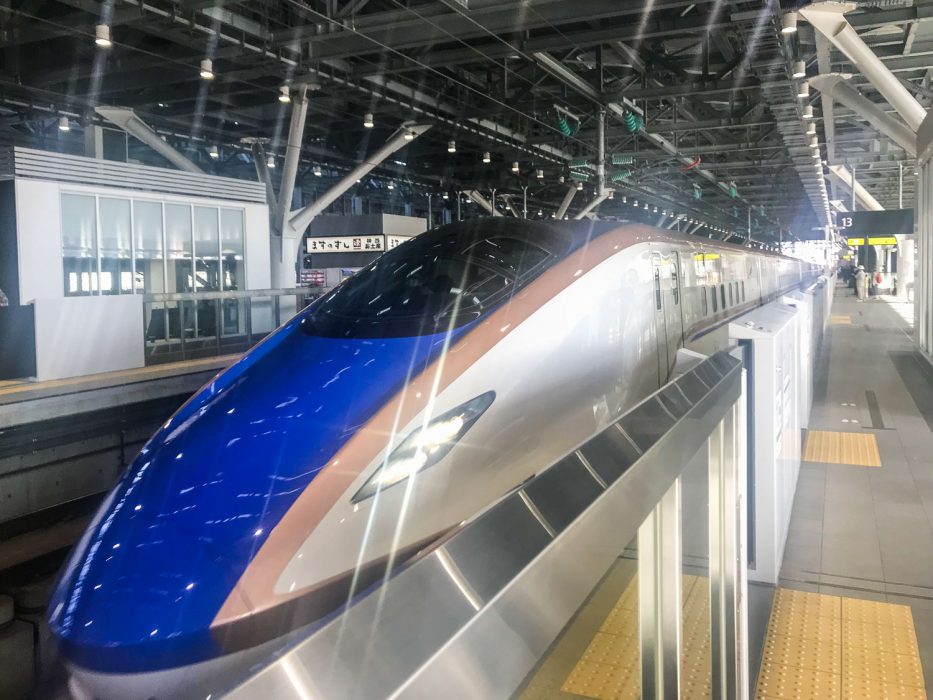
The rail pass can be used on some local trains within Tokyo and other big cities, but not on the metro or buses.
It’s mostly useful for saving money on travel between cities. See the local transport section below for more details.
Joyful Trains
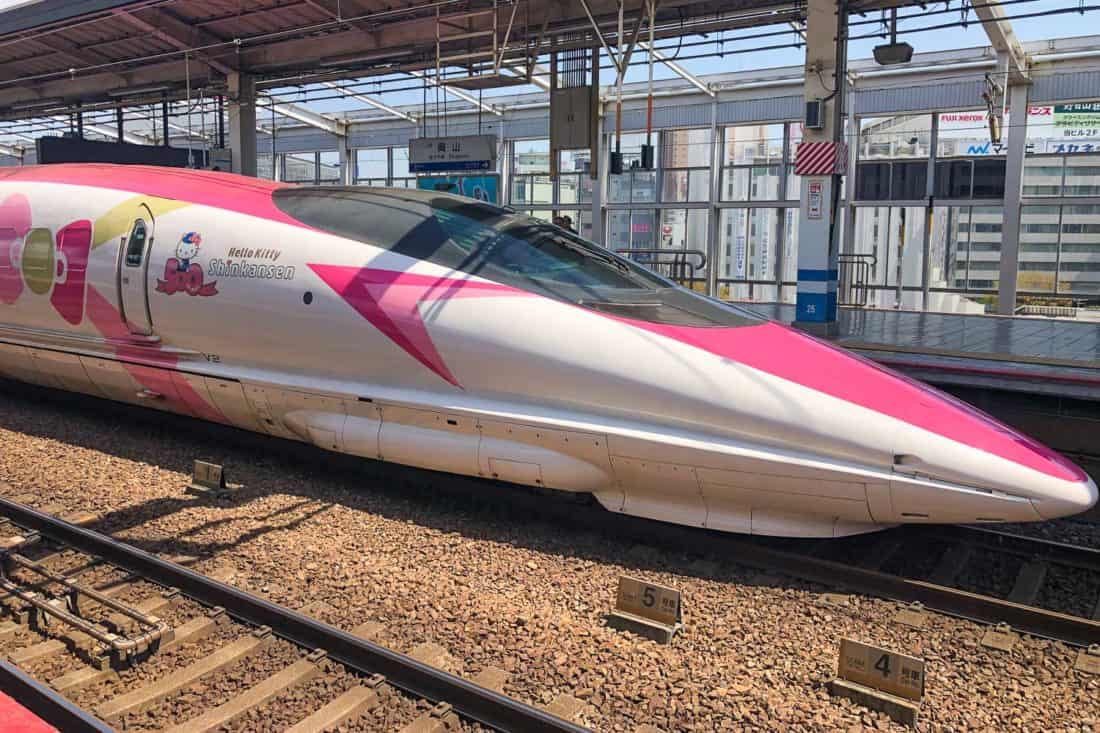
The JR Pass is valid on many of Japan’s Joyful Trains which are fun, character-themed trains.
We noticed the Hello Kitty shinkansen in Okayama station and were tempted to hop on for a joy ride (the advantage of a rail pass is you can follow whims like this).
Destinations where we couldn’t use a JR Pass
If you are only travelling to major cities, you’ll be able to use your JR Pass everywhere. For trips to some smaller towns, you may need to pay extra to take the bus or private railway.
Even with these extra expenses, the rail pass still saved us money on our three trips.
On our first trip we visited two places that we couldn’t access with our rail pass. For the mountain temple town Koya-san we used our pass to travel from Kyoto to Osaka and then bought a ticket for the private Nankai Railways train.
For the tiny town of Tsumago in the Kiso Valley we used our pass to get from Nagoya to Nagiso then paid for the bus to Tsumago.
On our second trip (see our two week Japan itinerary) we used our rail pass to get everywhere except Hakone where we bought a Hakone Free Pass from Odawara train station to explore the area by bus, train, ferry, and cable car.
The only other slight issue was having to take a slower train with one transfer to get to Nikko as you can’t use a pass for the direct train from Shinjuku to the Tobu Nikko station.
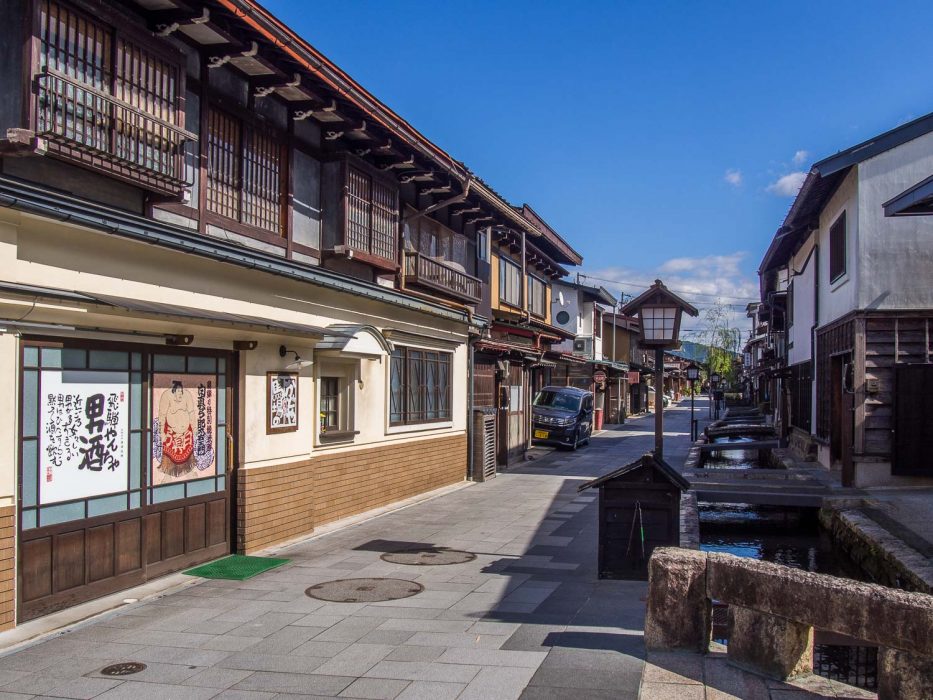
On our third trip, the only place we couldn’t get to with a JR Rail Pass was Kawaguchiko (to see Mt Fuji at Lake Kawaguchi).
We were travelling from Okayama (on the same line as Hiroshima) and could only take the shinkansen as far as Mishima where we took a 1.5-hour bus ride to Kawaguchiko.
From Tokyo you can get to Otsuki with a rail pass and only pay the regular fare for the final section to Kawaguchiko.
We also visited the very cool Naoshima Art Island as a day trip from Okayama. The rail pass covered our train to Uno port but didn’t cover the 20-minute ferry (which is inexpensive anyway).
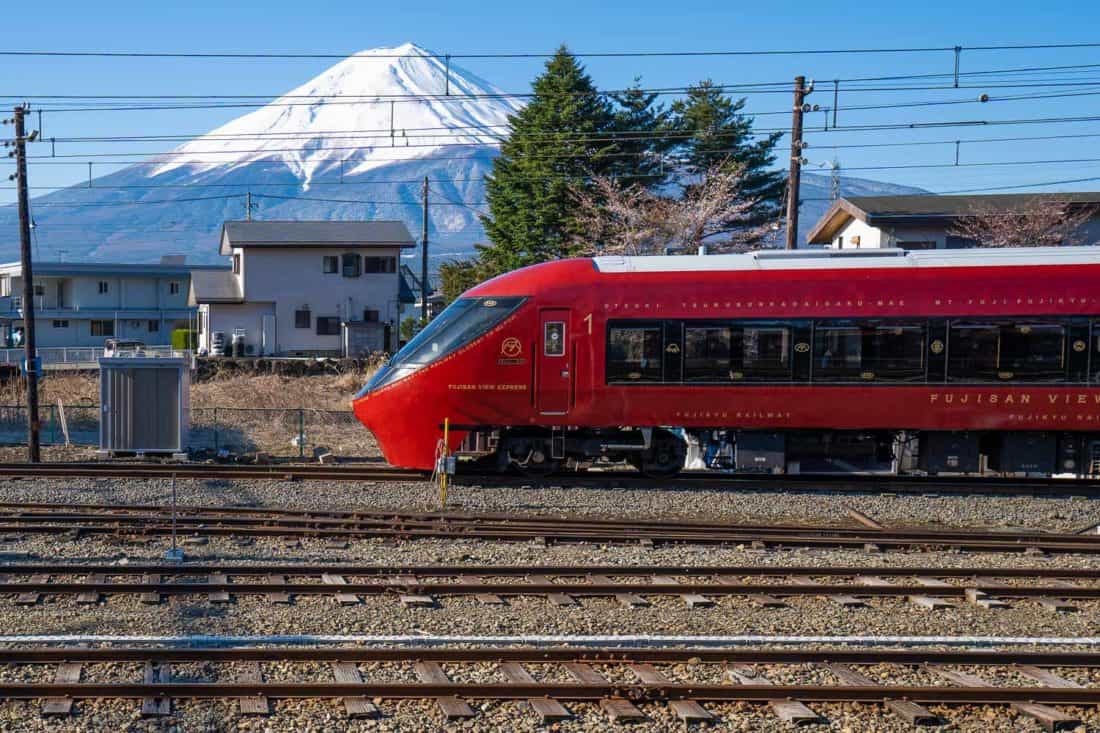
Is a Japan Rail Pass Worth It?
Whether a Japan Rail Pass is worth it for you depends on your route.
If you’ll be travelling at a fast pace to lots of places, especially on the expensive bullet trains, then a rail pass may save you money.
If you are only travelling from Tokyo to Kyoto and back within a week, the pass no longer saves money.
The return trip on the shinkansen costs ¥27,300 (for a reserved seat). You’ll have to do a lot of extra travel to reach the ¥50,000 cost of a 7-day pass.
Japan Rail Pass Calculator
To work out whether the JR Pass is worth it for you, you need to come up with a potential itinerary and then calculate how much it would cost to pay for your tickets as you go.
To get a rough idea use Japan Guide’s Japan Rail Calculator. It’s not 100% accurate, but it’s quick and easy to use.
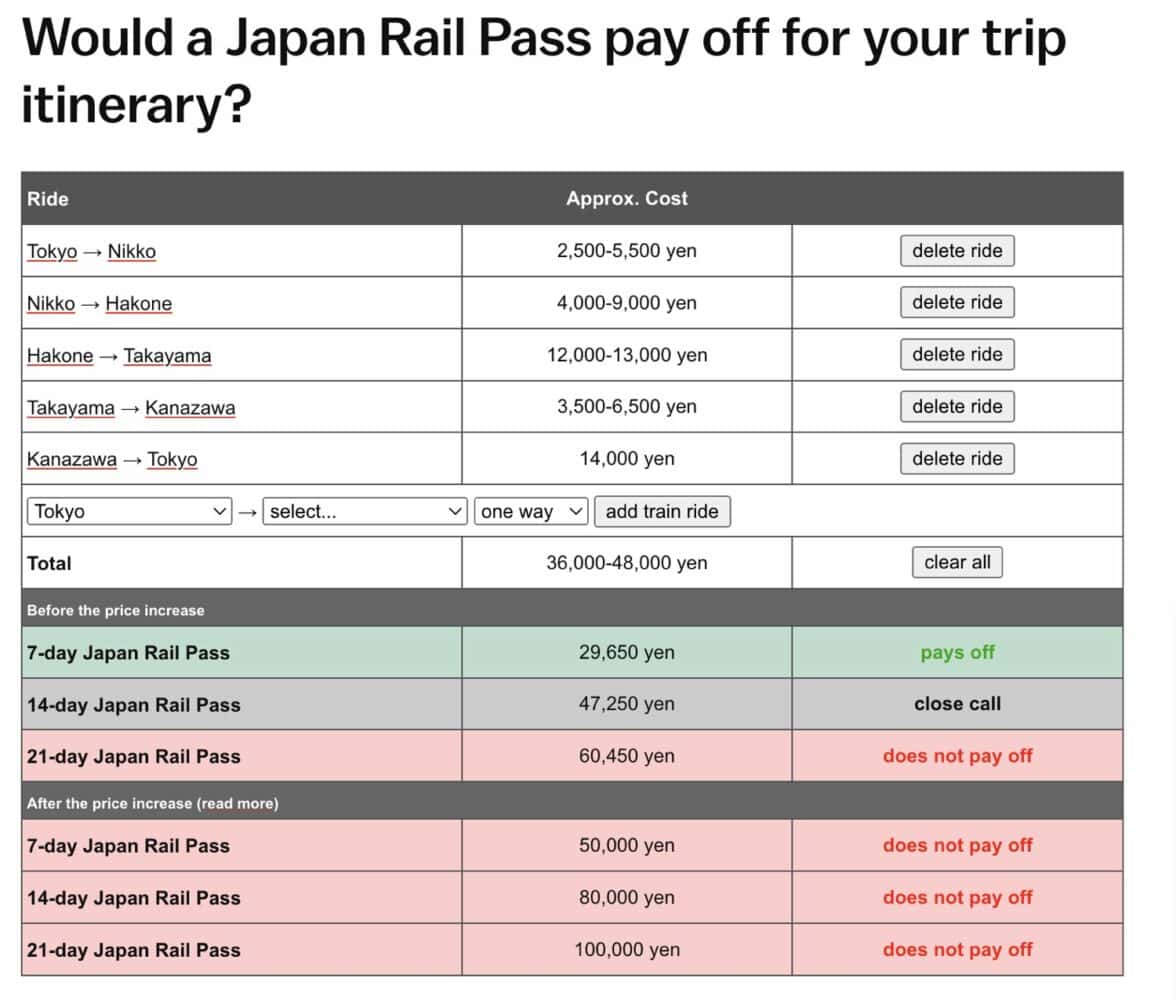
For an accurate calculation, put each leg of your trip into Navitime to see the costs.
If it’s a close call
If the cost of the pass is just a little more than individual tickets, I recommend buying the pass. It makes travel much easier not having to buy tickets and being able to hop on and off trains as you like.
You can also use the pass for some local travel (especially in Tokyo where it can be used on the trains but not subways) and day trips.
On a more unconventional trip from Kyoto-Kinosaki Onsen-Okayama (with day trips)-Mishima (for the bus to Kawaguchiko)-Tokyo we bought a 14-day Japan Rail Pass.
As we were travelling at a fairly slow pace, this worked out roughly the same price as if we’d bought the tickets individually (at the old pass price), but the convenience made it worth it.
Our Savings with a Japan Rail Pass
For a previous two week trip to Japan we flew in and out of Tokyo and used a 7-day Japan Rail Pass to travel to Nikko, Hakone, Takayama, and Kanazawa—see our detailed Japan itinerary.
Here are the savings we made by using a Japan Rail Pass. This includes a side trip from Takayama and using the pass for local trains in Tokyo on our final day with the pass.
| From | To | Cost in Yen |
|---|---|---|
| Tokyo Shinjuku | Nikko | 5,380 |
| Nikko | Odawara (for Hakone) | 8,200 |
| Odawara | Takayama | 12,000 |
| Takayama | Hida-Furukawa (side trip) | 240 |
| Hida-Furukawa | Takayama | 240 |
| Takayama | Kanazawa | 5,610 |
| Kanazawa | Tokyo Station | 13,920 |
| Tokyo Station | Shibuya (within Tokyo) | 200 |
| Shibuya | Takadanobaba (within Tokyo) | 170 |
| Takadanobaba | Shibuya (within Tokyo) | 170 |
| Total Cost of Individual Tickets | JP¥46,130 | |
| Cost of Old 7 Day Japan Rail Pass | JP¥29,110 | |
| Previous Saving | JP¥17,020 | |
| Cost of New 7 Day Japan Rail Pass | JP¥50,000 |
We saved over ¥17,000 or $115 per person with the old Japan Rail Pass.
Unfortunately, with the new Japan Rail Pass prices, we would have saved ¥4000 ($27) by buying tickets individually. In this case, I do think the pass would be worth the extra cost for the convenience.
A Tokyo to Kyoto Sample Itinerary and Savings
Here’s an example for a typical 10 day trip to Japan arriving in and departing from Tokyo and visiting the highlights.
Spend the first three days in Tokyo (pay out of pocket for the Narita Express train from the airport), and then activate your 7-day rail pass on the day you leave for Kyoto.
Spend six days in Kyoto and take day trips to Nara and Osaka (which are inexpensive on local trains) and further afield to Hiroshima by bullet train (where you’ll really appreciate the pass). See more Kyoto day trip ideas.
Return to Tokyo for your final day and use the pass to take the Narita Express train to Tokyo Narita Airport.
Here’s how much you would save by purchasing a JR Rail Pass for this itinerary:
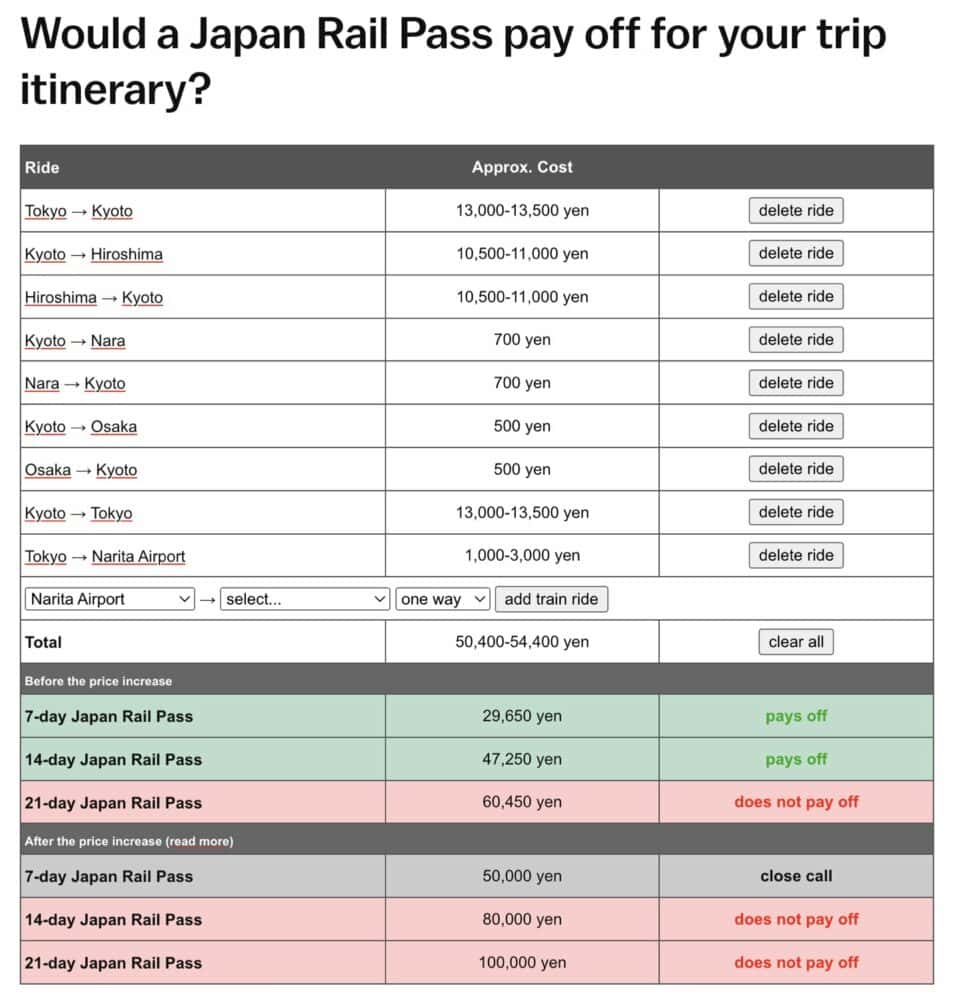
By purchasing a 7-day JR Pass for this trip, you used to save a considerable amount. After the price increase, buying a pass is about the same as individual tickets but could be worth it for the convenience.
When Not to Use a Japan Rail Pass
If you are flying into Tokyo and out from Osaka (or vice versa) and only travelling to Tokyo, Kyoto and Osaka, a rail pass will be more expensive than the one-way shinkansen ticket from Tokyo to Kyoto.
Or even if you are just travelling from Tokyo to Kyoto and back (without major day trips), buying individual shinkansen tickets is cheaper and you’ll be able to take the fastest Nozomi train.
If you are only travelling in one area of Japan, such as Kansai where Osaka and Kyoto are, paying for tickets individually will likely be cheaper than a JR pass. You might want to look into a regional rail pass instead such as the Kansai Area Pass (although those have also had price increases).
If you are on a really tight budget and are travelling at a slow pace, it could work out cheaper to take the bus. Willer offers bus passes from ¥10,200 for three days of travel within two months.
We much prefer train travel, though, as it’s faster, more comfortable and spacious, we can work on the tables, and I don’t get travel sick (a problem on the bus on Japan’s winding mountain roads).
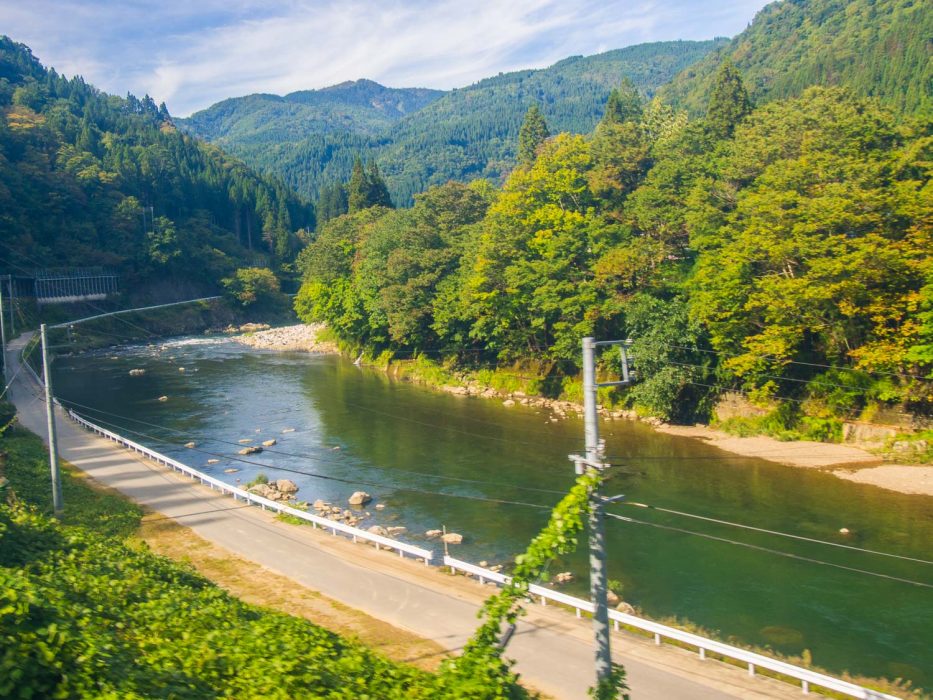
Where to Buy a Japan Rail Pass
Japan Rail Passes are sold by some travel agents outside Japan, but the easiest way to buy a pass is online.
We bought our passes for our last two trips from JRailPass.com who are an official JR Rail Pass vendor. You will receive an exchange order that you exchange for the pass when you arrive in Japan.
Another option is Klook, which has free global delivery.
The exchange order must be exchanged within three months, so don’t order too far in advance.
Our purchase with JRailPass.com was very easy. For each passenger you need the full name exactly as it’s written on their passport and their nationality.
You are also asked for an approximate arrival date in Japan, but this is just so they can make sure your passes will arrive on time. You don’t need to decide the exact start date of the pass until you get to Japan.
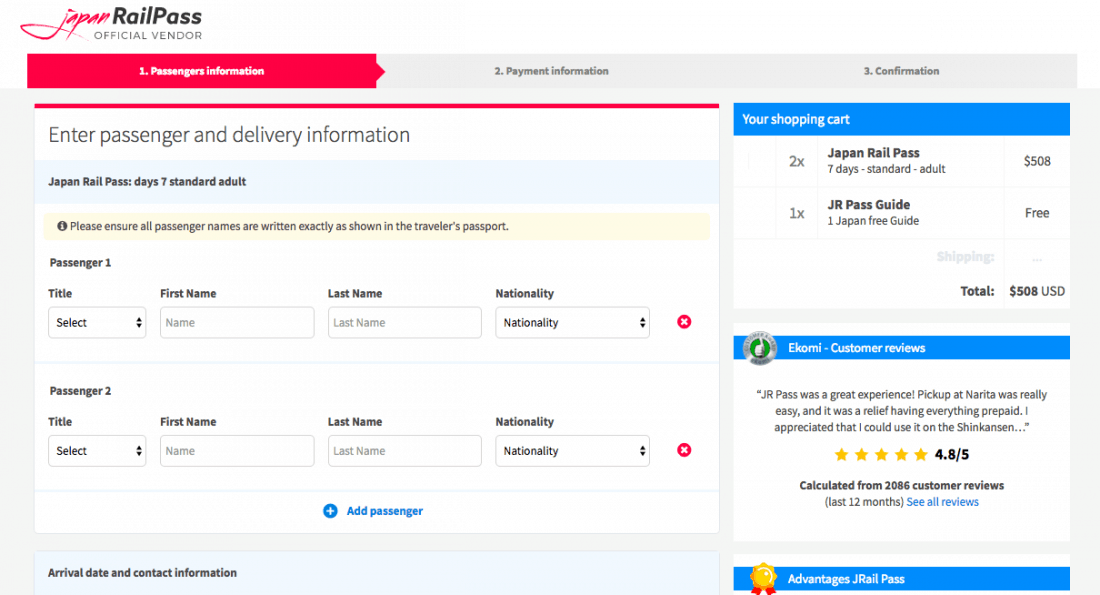
They can ship passes worldwide and they usually arrive within two working days, although ours took three days to Indonesia. On one of our trips we were already travelling so we got the pass delivered to our hotel in Bali.
There are extra credit card and shipping fees unless your order is over $600 when there’s free shipping to the UK and Europe.
In the US the passes are sent by UPS and worldwide they use FedEx International Priority. You are given a tracking number to track the progress of the delivery. Someone has to sign for the delivery.
Sending a Japan Rail Pass to Japan
If you’ve left buying your pass to the last minute, you can get the exchange order sent to your first hotel in Japan.
It’s best to check with your hotel or Airbnb host first, but it shouldn’t be a problem with bigger hotels.
On our last trip we were staying in an apartment in Kyoto for a month before we started our two-week rail pass trip.
As I wasn’t sure what would happen if we missed the delivery (and we wouldn’t be able to read any notices in Japanese), the agent who managed the apartment agreed to receive delivery for us.
Buying Direct
It used to be you could only buy a pass outside Japan from an authorised agent, but Japan Rail now sell passes online (they stopped selling them at certain stations). See the Japan Rail Pass website for more details.
The downside of booking direct is having to deal with a somewhat clunky site (where you have to create an account).
The upsides are not needing to have an exchange order mailed to you in your home country (you collect the pass in Japan) and being able to make seat reservations online (even before you arrive in Japan), which could be useful at very busy times of year like Golden Week.
How to Exchange a Japan Rail Pass
You don’t receive the pass at first but an exchange order that you can then exchange for your pass when you arrive in Japan.
A booklet with information on where you can do this comes with the exchange order.
We exchanged ours at the JR Rail office in Shinjuku Station and it was quick and easy.
We had to fill in a short form and show our exchange order and passports (don’t forget to bring yours). You have to choose the start date for the pass within the next month and this can’t be changed.
If possible, it’s best to do this a day or so before your first travel day so you don’t have to worry about it on the day.
Otherwise, make sure you allow plenty of time before your train departs in case there are queues.
Can You Use a Japan Rail Pass for Local Transport in Tokyo and Kyoto?
For local transport within cities you can use the JR Rail Pass on some train lines but not the metro or buses.
As local transport isn’t very expensive (with the exception of the fast airport trains), it might not be worth activating your pass until you leave the city. See above for how to calculate this.
Tokyo Local Travel
In Tokyo, the Japan Rail Pass is quite useful. You can use it on the JR Yamanote line, which is one of the most used lines in the city and connects major hubs such as Shinjuku, Shibuya and Tokyo Stations.
There are a number of other JR train lines that crisscross the huge city—the Chuo line is another one we often use.
You can’t use a JR Pass on the Tokyo Metro.
The pass can be used on the Narita Express train which is the most comfortable and quickest way to get from Narita Airport into the centre of Tokyo.
You can activate your pass at the JR Travel Service Centre in the airport train station.
Kyoto Local Travel
In Kyoto, the pass is of more limited use for local transport. You can’t use the pass on the metro or buses, but there are a couple of train journeys you could use it for.
You can take the JR Nara line to Inari (to see Fushimi Inari shrine—one of our top things to do in Kyoto).
You can also take the JR Sagano line to Saga-Arashiyama station to see the famous bamboo grove and many beautiful temples in this neighbourhood.
If you are flying into Kansai Airport near Osaka, you can activate your rail pass at the airport train station and use it for the Limited Express Haruka train, which is the best way to get to Osaka or Kyoto.
Osaka
Although there are a few JR train lines within Osaka, the Osaka subway is more useful for getting around, and this is not included with a rail pass.
Local Transport Cards
As you can’t use a JR Rail Pass on many forms of local transport within the cities, you’ll want to pick up a prepaid IC transport card.
You add money to these in advance and then just tap on and off all local transport.
In Tokyo you can buy a Suica or Pasmo card and in Kyoto and Osaka you’ll get an ICOCA card.
Whichever card you buy you can use them in cities all over Japan, so you don’t need a separate card for Kyoto and Tokyo.
You used to be able to buy them at ticket machines and counters in train and metro stations, but sales can be limited due to a shortage of IC chips.
Tourists can still purchase Welcome Suica and Pasmo Passport cards at select stations and airports. They are only valid for 28 days though.
An easier option is to add Suica or Pasmo to Apple Wallet on your phone or watch (currently only Mastercard and American Express work as payment methods for it in Wallet though).
The old IC cards included a ¥500 deposit, which you can get a refund for if you return your card at the end, but only in the area you bought it. You can’t get a refund for a Suica card in Osaka or an ICOCA card in Tokyo.
The tourist cards don’t have a deposit.
Finding Train Times
Use Navitime to search for train times. Remember to click the Tourist Pass dropdown menu and select Japan Rail Pass to have it show routes where the rail pass is valid.
Making Seat Reservations
You don’t need to make seat reservations to travel with a pass on most trains—you can just hop on any unreserved car.
The most commonly used train that does require a seat reservation is the Narita Express from Narita Airport into Tokyo.
If you want to use your pass on the airport train, you can swap your exchange order for a pass and get the seat reservation at the airport JR office.
You probably want to make seat reservations when travelling during Japanese national holidays—see this list of Japan holiday dates.
Seat reservations are free for rail pass holders and can be made at any JR station ticket office—either at the counter or at ticket machines.
It doesn’t have to be the station you are travelling from, so you can save time by getting a few seat reservations at once. Smaller stations will have shorter queues.
You could also make your first few seat reservations when exchanging your exchange order for a pass. We did this in Kyoto Station on our last trip, which saved time as the queues were long.
All you have to do is show your pass and give them the train time you want the reservation for.
Staff may speak English, but I find it helpful to write down the date, train time, and route I want reservations for. This is why it’s best to research times on Navitime in advance.
Luggage Reservations
If you are travelling on the Tōkaidō, San’yō, or Kyūshū Shinkansens and have oversized luggage, you’ll need to make a seat reservation for the seats next to the oversized baggage area at the end of the train car.
Luggage is considered oversized if it has total dimensions (A+B+C) of over 160cm.
This is fairly generous as most standard suitcases are smaller than this. Smaller suitcases, including any that fit in airline overhead compartments (including our Away Bigger Carry On), should fit in the overhead compartments on shinkansens.
Even if your bag is not oversized, you can book an oversized luggage seat to have access to the storage area behind the seat if you think you’ll have problems lifting your baggage overhead.
How to Use a Japan Rail Pass
To use the Japan Rail Pass all you need to do is get on an unreserved car and find an empty seat.
In 2023, the format of the pass changed and it’s now a small scannable ticket that you can use in the automatic gates to access the train platforms.
You may also be asked to show the pass on the train.
When you are travelling on a bullet train you can see which cars are unreserved on the screens, and then find the corresponding number on the platform to see where to wait.
The panels on the side of the carriage will also say whether it’s reserved or unreserved.
Trains are always on time so a 10-minute transfer time is fine.
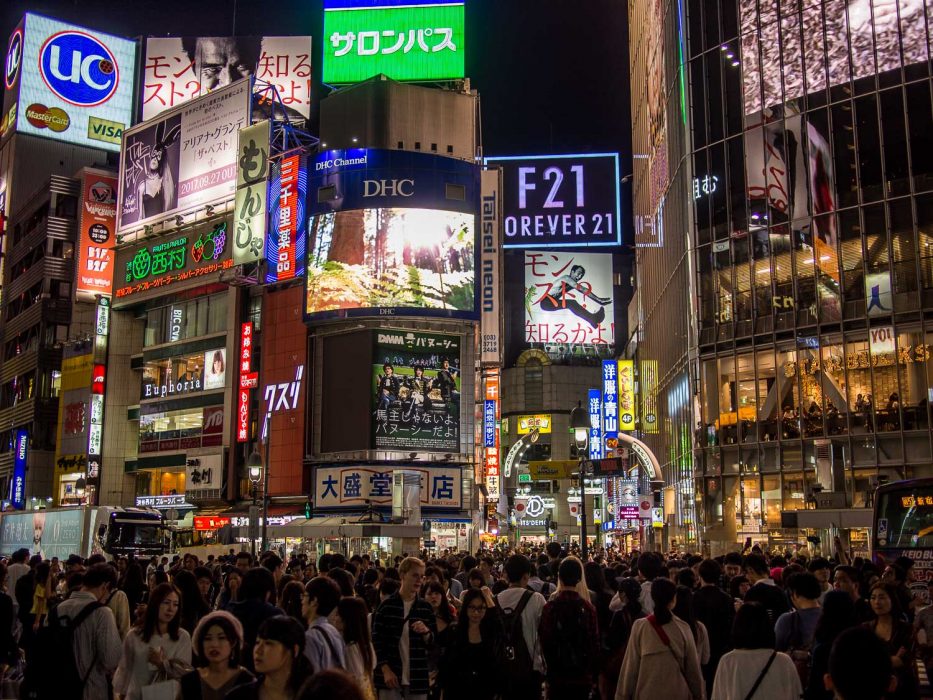
Japanese Train Etiquette
The Japanese are generally a quiet and respectful people and it’s important to follow these rules when travelling by train:
- Be quiet – Keep your volume low when taking, don’t talk on your phone and make sure it doesn’t beep or ring. We even saw signs warning you not to type too loudly on your laptop!
- No eating – The exception is on bullet trains when buying a bento lunch box at the station is a big part of the experience. On local trains we didn’t see anyone eating or drinking anything other than water.
- Don’t smoke – Unless there’s a designated smoking car on the bullet trains.
- Don’t sit in the priority seating – On local trains these seats are designated for the elderly, pregnant women, and people with disabilities. If the train is quiet you can sit here, but be prepared to give up your seat if necessary.
- Queue – There are designated spots to wait for the train marked on the platform, so join the orderly queue.
- Be patient – Stand to the side and wait for people to get off the train before you get on.
Is a Japan Rail Pass Worth it?
On our earliest trips to Japan, we found a JR Pass saved us hundreds of dollars and made travel much easier.
While that has changed with the price increase, it’s still worth considering a rail pass if you are doing a lot of travel.
Even if a pass costs about the same as individual tickets, the convenience of being able to hop on almost any train without buying a ticket is worth it.
On our latest trip, a Rail Pass didn’t work out worth it for us, so we travelled around the country without it for the first time. We definitely missed our pass when we made a major mistake purchasing Shinkansen tickets from a machine!
Hopefully the tips above will help you work out whether a Japan Rail Pass is worth it for you.
Let me know if you have any questions in the comments below.
More Reading to Plan Your Japan Trip
- Two Weeks in Japan: A Detailed Itinerary
- 56 Best Things to Do in Japan for an Unforgettable Trip
- Planning a Trip to Japan: Dos and Don’ts
- 16 Unmissable Places to Visit in Japan
- Where to Stay in Japan: The Ultimate Guide to Accommodation
- Vegetarian Survival Guide to Japan
- 26 Cool Things to Do in Tokyo
- 31 Unforgettable Things to Do in Kyoto
If you enjoyed this post, pin it!
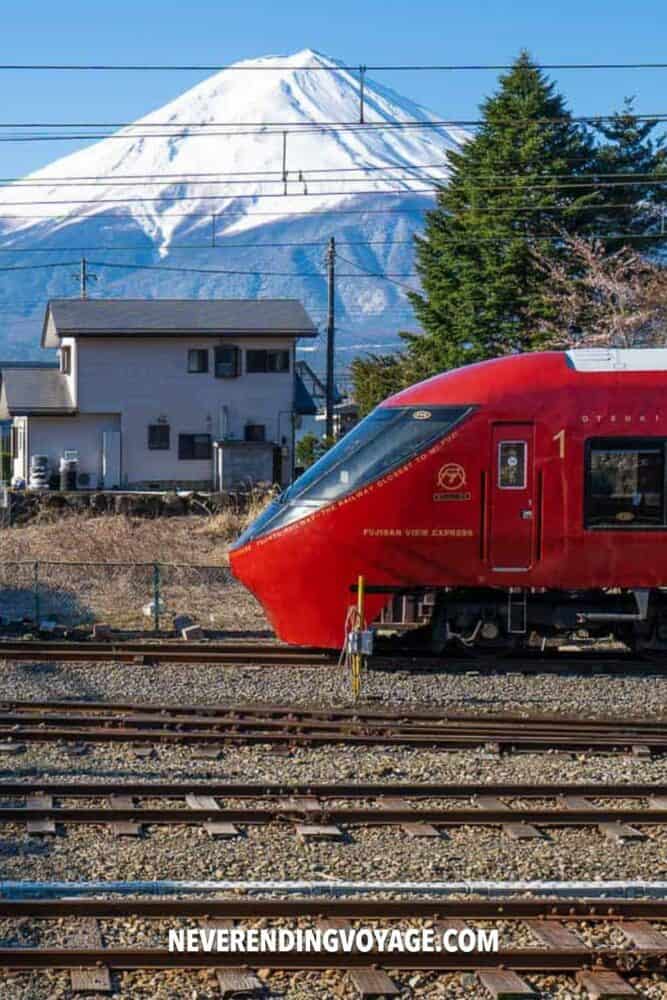
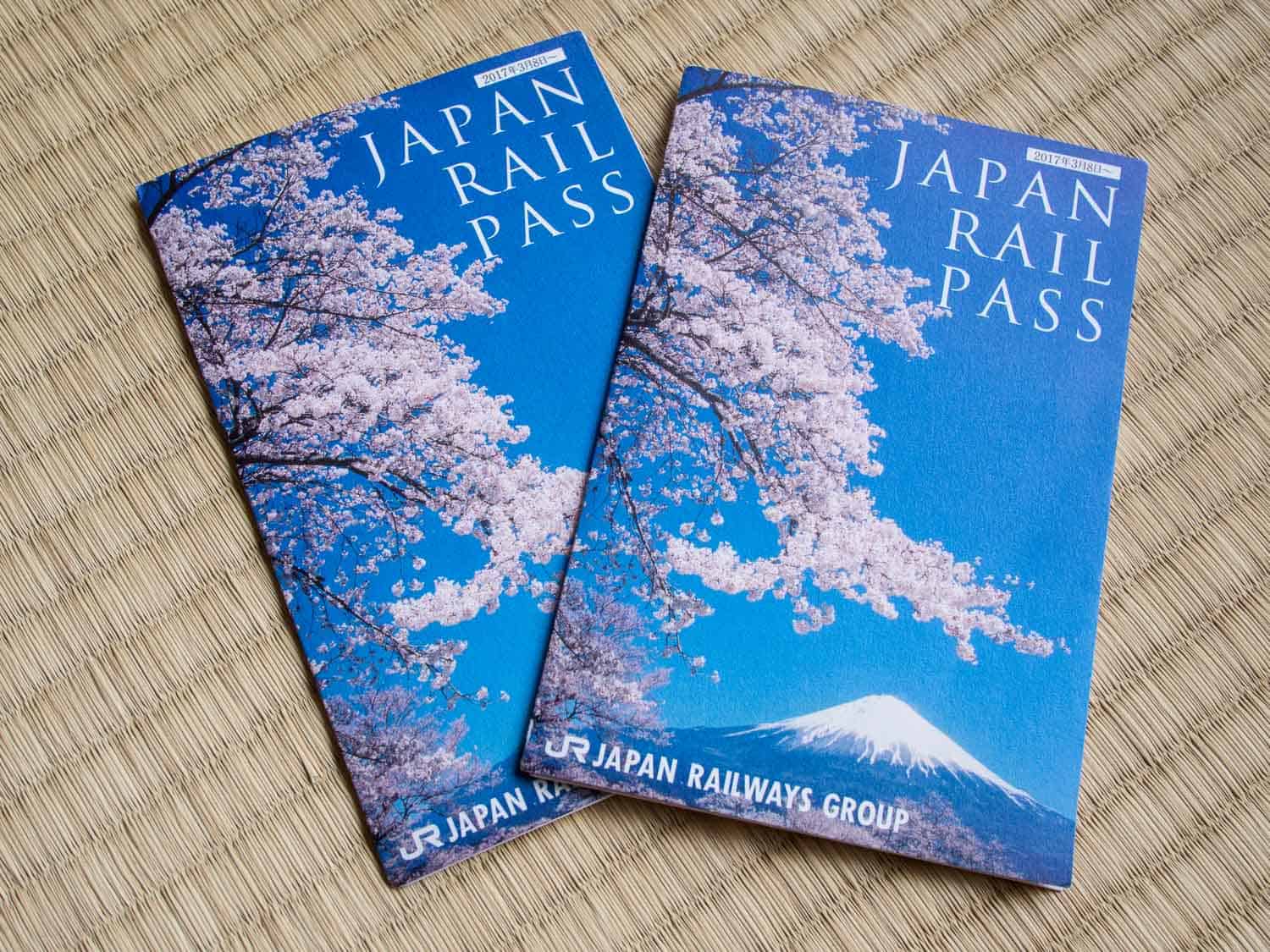
This, and all the other links were very useful and I just wanted to say THANK YOU!
Thanks very much and I’m glad you found them useful!
Hi, Thank you for all your knowledge and information! We are planning to arrive into Narita airport and take a train to Izu- Mount Fuji – Azumino – Liyama – and back to Tokyo for a two week trip. Do you think it makes sense to buy the 2 week pass or each time we travel by train? I understand The Passes have to be used consecutively…Also, it seems the train doesn’t go to the Fujikawaguchiko area, is this only accessible by bus or car? Maybe we should skip Mount Fuji as it looks complicated to get there without a car…and from Izu go back to Tokyo and onto Nagano ( Azumino)? Thank you for your help. We have been to Japan once and loved it! Although we have never used the rail system which we would prefer to try instead of renting a car.
You can use the calculator I linked to in this post to get a rough idea of whether a rail pass is worth it for this trip. At a guess, I would say it won’t be as you aren’t travelling huge distances and would need a two week pass.
You can get to Kawaguchiko by train. My guide has the information on how to get there from Tokyo: https://www.neverendingvoyage.com/lake-kawaguchiko/
I would use Navitime to see how to get there from Izu. You may have to go through Tokyo.
Hakone is another option to see Mt Fuji and is closer to Izu. Again you’d have to check transport routes depending on where you are coming from. You can get a train to Odawara and then a bus from there, which is what we did in this itinerary: https://www.neverendingvoyage.com/japan-2-week-itinerary/. It wasn’t difficult.
Good luck with the planning and have a wonderful trip! Erin
Hello, thank you very much for creating such a helpful and useful guide for people who never been to Japan.
Can I ask if for example using a 2 Weeks in Japan: The Perfect Itinerary for First Time Visitors Guide, Is it worth it for a Japan Rail Pass?
See the section of this post “Our Savings with a Japan Rail Pass” for a breakdown of that itinerary. With the new prices it’s slightly cheaper to pay individually but the pass could be worth it for convenience.
30 March 2025 – 9 April 2025
30.3.25 Osaka
31.3.25 Osaka / Kyoto
1.4.25 Kyoto
2.4.25 Kyoto
3.4.25 Nara – Kyoto
4.4.25 Kyoto / Tokyo (3 hrs)
5.4.25 Tokyo
6.4.25 Tokyo
7.4.25 Lake Kawaguchiko (Mt Fuji)
8.4.25 Tokyo
9.4.25 Tokyo / Singapore
May I know is it worth to buy JR pass for the above plan? Thanks
Probably not but you can use the tool listed in this post to be sure.
Hi, throughout your blog and on other posts I’ve seen, there are other train lines mentioned other than the JR line, depending on the location. I’m a bit overwhelmed by all the options. Is there an easy way to determine how long other train lines take and cost, based on my itinerary? Thanks in advance!
The Navitime website/app is the best way to look up train times and routes: https://japantravel.navitime.com/en/area/jp/route/
You can choose Japan Rail Pass as a filter to only see JR trains, otherwise it will show them all.
Hello Erin – we travel the world and the first thing we always do when planning is look for great blogs. Yours was one of the most informative I have ever read, and so complete. And the special links to more detailed blogs was wonderful. It must have taken you hundreds of hours to write, but it’s so appreciated. So thanks so much.
Thank you, Paul! I really appreciate your kind words. Happy travels!
Ordering the pass online is very easy, collecting at a station is a bit of a pain. Seat reservations online are really easy, it saves battling with the reservation machines.
Buying an upgrade for a Nozomi should be included in the website. The queues even in March lose any saving in time of going by Nozomi.
there are 14 of us (3 children and 11 adults) staying in Japan 14 days. Flying into Tokyo then bullet train to Hiroshima and regular train to Miyajima. Then back to Hiroshima and to Himeji and back to Tokyo. Then Tokyo to Nikko and back to Tokyo. Would the Regular JRP be worth it, plus we’ll be taking the train around Tokyo, Kamakura etc.
It probably wouldn’t save you money and if you don’t get a pass, you can take the fastest Nozomi train to Hiroshima (which costs extra with the pass). Your most expensive trips will be Tokyo – Hiroshima – Himeji – Tokyo. The side trips are on local trains and pretty inexpensive. Enjoy Japan!
We are going for 21 days and staying in many cities, i think after the increase of the price 70% tickets, maybe it doesn’t make sense the JR pass, just have local pass and buy the big trips.
What do you think?
It really depends where you are going – it’s worth doing the calculation based on your trip. But yes, it’s unlikely to save you much money.
On our trip earlier this month, we got a Suica card on Apple wallet, which we used for city travel and local trains (Osaka to Kyoto for example) and we bought our shinkansen tickets online on the SmartEx website.
Be prepared to spend several hours waiting in line at JR office to exchange for actual JR Pass with no internet connection.
I’m sorry your wait was so long. We’ve never had that problem before.
Hi Erin. It is actually a big relief for me when I found out that you also purchased your JR passes from jrailpass.com. I have just purchased mine via the same site as well, but thereafter I found some reviews online saying that the site was a huge scam. I have received a purchase confirmation via email but have yet to receive any tracking number for the delivery. The invoice states that the company is situated in Spain, so that somehow got me panicking. I browsed for more reviews and fortunately came across your posting. Phew!
Yes, no need to worry! We’ve ordered from them twice with no problems. Have a wonderful trip to Japan!
Hi Zaidi, did you get your pass? How long did it take to arrive?
Thanks so much!
Hello.
If we buy a 7day pass, do we need to use it for seven consecutive days ?
We are hoping to stay five days in Tokyo and Five days in Kyoto. The five days in between and at the end of our holiday we hope to travel with a rail pass.
Yes, I’m afraid it is seven consecutive days. So you’ll need to work how much travelling you’ll be doing in each 5 day period and if it’s worth getting two passes. Enjoy Japan!
Hi, I’m not sure if you’ll see this, but my boyfriend and I are wanting to travel to Japan for our 8 year anniversary. Definitely interested in using the JP rail pass, but was wondering, do they have any for couples/duo passes? Or would we need to get one each?
You need to get one each. Enjoy Japan!
me and my partner will travel to japan this feb 2023 for 7 days. We will stay in Nagoya and planning to go to osaka and kyoto for 3 days and then back to nagoya. Do you think it will be worth it to use JR pass for this trip. Thank you in advance
It probably won’t be worth it unless you are also using the pass to get from Tokyo airport to Nagoya, in which case it will save you money.
You can use the tools mentioned in the post to work things out more exactly based on your plans.
Enjoy Japan!
Hi,
Thank you for your blog of knowledge :)
I am taking my family to Japan, we will be there for 10 days – you mentioned that you can activate the pass later on? Could you explain that further? Thank you. I think It would be best if we waited 3 days, then activated our 7 day pass.
During your first 3 days in Japan take your passes to a JR office in a train station and you can choose your start date and activate it. You’ll then be ready to go on your third day (or whenever you choose to start it). You get more detailed instructions on where to go when the pass is mailed to you.
Hi All,
We are a family of four and planning to travel to Japan on June 07, 2020, for a week. Would you recommend us to purchase the JR Pass? We are two adults and 2 children (17 and 14-year-olds)
Would you also recommend where we should stay on the budget?
Thanks and Regards,
Long Nguyen
It really depends where you are going. You need to plan your route first then calculate how much it would cost if you buy tickets individually (using the tools in this post).
I use Booking to find hotels and Airbnb (for apartments in the big cities) and you can sort by budget. Osaka is cheaper than Tokyo and Kyoto if you find them too expensive.
Enjoy your trip!
Hi, I’ve read so much about JR passes I’ve just totally confused myself and was wondering if I could ask some questions please?
We are travelling in January 2020. We will arrive in Tokyo on a Wednesday night, and will depart after 6 days the following Tuesday to Kyoto. However while we are in Tokyo I want to go to Odaiba island and also on a trip out to Lake Kawaguchiko, as well as use the subway around Tokyo.
We will be in Kyoto 4 days, but I want to travel to Nara Deer park and the Suntory Distillery. Would we do this with a JR pass or other train lines?
Then we are travelling to Osaka for 3 days. On one of those days I would like to travel out to Hiroshima (and we will have to return to Osaka). We will need to get from our hotel in Osaka to the airport to depart for home.
You won’t need the rail pass while you are in Tokyo – it’s not worth it for the subway (get a Suica card and top it up with cash instead) and the rail pass doesn’t cover the entire journey to Kawaguichiko.
It would probably be worthwhile to get a 7 day pass to cover your Tokyo-Kyoto-Osaka-Hiroshima-airport section. This works out mainly because the bullet train from Osaka to Hiroshima and back is so expensive (without that trip it wouldn’t be worth it). You could also use the pass to get to Nara and the distillery.
I hope that helps! You can do a more exact calculation on Hyperdia.
Wow amazing article, really really helpful! I’m planning 8 days trip Tokyo -> Kyoto -> Osaka. I don’t really know yet what’re the must-see places once I get to each city and quite concerned I’d need to go somewhere nearby say Kyoto/Osaka using the JR Pass. Based on your article, I guess the best for me would be not to buy the the JRPass since I’ll mainly need it for Tokyo -> Kyoto and then Kyoto -> Osaka short ride. I checked what I’m saving if I don’t buy it, it’s around 70 euros (77 usd), do you think I could be using it for nearby places once in Kyoto/Osaka?, can I also use it from the airport in Kyoto to town? I appreciate your response :)))
The pass probably won’t save you money as the local trains (including Kyoto to Osaka) are quite cheap.
It’s only if you decided to take a bullet train (say to Hiroshima or Himeji) on a day trip from Kyoto/Osaka that you would probably save. With 8 days you probably won’t have time though. Here are some day trip ideas: https://www.neverendingvoyage.com/day-trips-from-kyoto/
You can use the pass for the train from Kyoto to Kansai Airport.
We are in Japan at the moment and bought the Kansai-wise area pass (as that’s where we are spending most of our time on this trip). To be honest, although the JR pass has technically saved us money, we wouldn’t recommend it. It seems that with the pass, you can’t use the most convenient routes/stations/timetable. In most cases, the local subway/loading up Suica is far more convenient to get where we want to go as it seems the JR stations and routes are out of the way/ longer and have more transfers as compared to other companies. Note also Suica can be reloaded via an app on your phone. We have definitely felt it was a second class pass and would have gladly paid the few extra dollars in retrospect for the convenience of getting to our destinations quicker and with more ease. We did run the calculator before hand but what it didn’t tell us was how much longer the JR would take and the less convenient location of stations relative to our destinations.
I’m sure in some cases it makes sense, just wanted to relay our experience.
It does seem the Kansai area pass is less good value that the country-wide JR Pass (which is what I discuss in this post). As the distances you are covering aren’t huge the local trains aren’t too expensive. It’s only when you are taking bullet trains on the longer routes that the rail pass really saves money (which doesn’t apply within Kansai).
The Suica card is definitely a handy way to travel locally and you can even use it in other cities (outside of Kansai) too.
hi ERIN Hope you are doing well…You and Simon are living the LIFE…I’m American but so fatigued living in TX..
How are ya’ll staying in Japan long term? Is there a specific visa you are using?
What’s your favorite city/town in Japan for living? Kobe, Osaka or Tokyo? I’m not a drinker/party goer–desires a walking city with cool vibe
Hi Jeff,
We’re not in Japan long term but have visited 5 times. We were last there from October to December on a tourist visa.
We haven’t been to Kobe yet but Kyoto is our favourite city for longer stays. It’s more walkable than Osaka or Tokyo and not as high rise (at least in the older parts of the city).
Does the 7 day JR pass have to be activated upon arrival when using the Narita Express
Yes, if you want to use it for the Narita Express. You can activate it at the Jr Travel Service Centre at Narita airport.
If you are spending a few days in Tokyo first it might make sense to pay for the Narita Express out of pocket and then activate the pass for the day you leave Tokyo. It depends on your itinerary.
Hi,
First of all thank you for such thorough article about the JR pass. I have two questions:
1.Is klook a reputable company to buy my JR passes from?
2. I am staying in japan for 15 days. After making my calculations it behooves me to buy a 14 day pass. I need one extra day. For that extra 1 day, Do I buy that in advance from my country or buy it in japan (it’s a one way ticket to Narita airport from Tokyo)?
Thanks a million. I found your blog very useful
Hi Venuse,
1. Klook are a reputable company although we’ve never used them. We always buy our tickets from J Rail Pass
2. You can buy the ticket from Narita to Tokyo at the station from the self-service machines or counter. No need to book in advance. We always get the Narita Express train which goes direct to Shinjuku as it’s comfortable and spacious and you get a seat reservation when you buy the ticket. You can get cheaper local trains but they can be very crowded.
Enjoy Japan!
I need some input on wether to take the 14 days JAPAN RAIL PASS or just go with local trains/busses, etc.
From 2-22 April we will be discovering Japan, flying in on Osaka and out from Tokyo. For 21 days in total.
Our planning is as followed:
Osaka 3 night (Daytrip Universal Studios)
Kyoto 7 night (Daytrip Nara)
Hakone 2 night
Mt Fuji 1 night
Tokyo 7 night (Daytrip Nikko) fly out from here)
Would you recommend to still get the 14 days pass or just travel one way tickets and use local passes?
It probably will be worth it but I recommend putting your planned trips (including side trips) into this calculator to see: https://www.japan-guide.com/railpass/
If it’s close get the pass because it’s easier than buying tickets for each journey. Enjoy Japan!
I am planning to visit Japan during the Golden week ( 26th April to 6th May 2019) I am planning to visit Tokyo also surrounding places and a round trip from Tokyo-Kyoto, also nearby places near Kyoto. Do you recommend me to go for JR pass during this time (Golden week)? Would really appreciate your help here.
I’ll be going to Japan in late September for 15days. I really want to rent a car but i see a lot of sites that recommend using the rail system. We plan on driving the whole island. For this kind of trip, do you suggest we rent a car or rail trail?
The vast majority of visitors to Japan travel by train because the network is very efficient and comfortable and it’s much easier than driving. Traffic can be bad in the cities and parking is a challenge. Although in many places we like to rent a car, in Japan the trains are the way to go.
I would only recommend renting a car if your trip is only to rural areas.
Japan is made up of multiple islands and 15 days is not enough time to see the whole country. Here’s the two week itinerary we followed on our last trip for an idea of what’s possible in that time frame: https://www.neverendingvoyage.com/japan-2-week-itinerary/
Have a great trip! Erin
I will be traveling only around tokyo and possibly a few days in kyoto. I am just starting to do my research for my trip in march and will only be in tokyo for 6 days, would you say just using the subway system to get around places like Shibuya, Asakusa, and Shinjuku or would you reccomend a JR pass? thanks so much for the awesome post, it has already helped me with planning :)
You don’t need a JR Pass for just Tokyo (or even one way Tokyo-Kyoto). Pick up a Suica or Pasma card from a train/metro station and put some credit on it to get around (it’s easier than buying an individual ticket each time). We have more info on Tokyo here: https://www.neverendingvoyage.com/cool-things-to-do-in-tokyo/
Enjoy your trip!
Hello. Does the JR work for the Tokyo Subway?
It doesn’t work on the Tokyo subway, but it does work on the JR train lines in Tokyo such as the JR Yamanote line which is a useful one for getting around (between Shinkuku and Shibuya for example).
Thanks for all his helpful information! We are going to be in Japan for 9 days. If we get the 7-day pass, will it only last for 7 consecutive days from the time we use it, or is it just the days you use the train?
It will only last for 7 consecutive days. If you start your trip in Tokyo you could spend a few days there before activating your pass and just pay for the airport train separately. Have a great trip!
Hi. Is the 7 days JR pass worth it from Narita airport to the city center and then, to Osaka Kansai on the 6th day? Thank you very much. This website is very informative. ???
It won’t be worth it for a one way trip to Osaka so just buy your tickets separately. Have an amazing time in Japan!
Is the JRP feasible if I’m planning a trip to Tokyo, Kyoto, Mt. Fuji (Hakone), Osaka & Kobe? Also, can we use the JRP within the cities? Or do we require another train pass? What are alternate (and cheaper) modes of transportation within cities in Japan? Pls advice.
P.S: Love how informed your blog is. :)
I think a rail pass would work out good value for that itinerary. You can use the pass on trains within Tokyo (there’s an extensive network) but not the metro. In other cities you can travel by bus or metro. We usually just bought tickets as we went but there are usually day passes if you’ll be travelling around a lot. Have a great trip!
Great post on the Japan rail pass never ending voyage. We’ve done a number of different trips to Japan over the years and sometimes the pass was worth it, other times it wasn’t. It really depends upon how many shinkansen trips a traveler is going to take.
For our most recent trip, we spent the month of October in the Kansai area (mostly) and we decided to NOT buy a pass. It just worked out cheaper that way.
I agree that the shinkansen trips make all the difference – they are so expensive to pay for without the pass! And yes, if you focus on just one area it probably won’t be good value to buy the pass. How lovely to spend a whole month in Kansai!